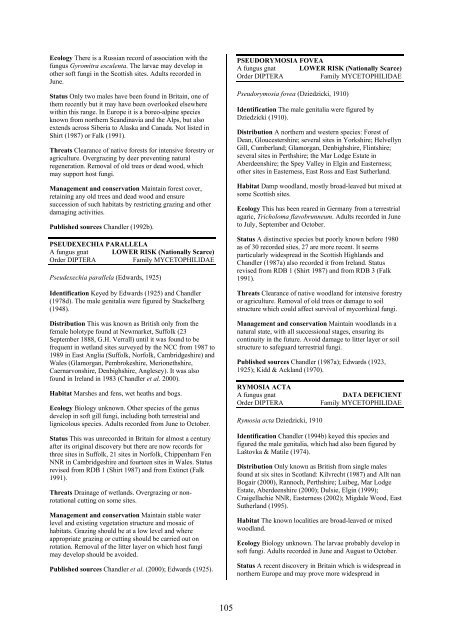Part 2: Nematocera and Aschiza not dealt with by Falk (1991) - JNCC
Part 2: Nematocera and Aschiza not dealt with by Falk (1991) - JNCC
Part 2: Nematocera and Aschiza not dealt with by Falk (1991) - JNCC
You also want an ePaper? Increase the reach of your titles
YUMPU automatically turns print PDFs into web optimized ePapers that Google loves.
Ecology There is a Russian record of association <strong>with</strong> the<br />
fungus Gyromitra esculenta. The larvae may develop in<br />
other soft fungi in the Scottish sites. Adults recorded in<br />
June.<br />
Status Only two males have been found in Britain, one of<br />
them recently but it may have been overlooked elsewhere<br />
<strong>with</strong>in this range. In Europe it is a boreo-alpine species<br />
known from northern Sc<strong>and</strong>inavia <strong>and</strong> the Alps, but also<br />
extends across Siberia to Alaska <strong>and</strong> Canada. Not listed in<br />
Shirt (1987) or <strong>Falk</strong> (<strong>1991</strong>).<br />
Threats Clearance of native forests for intensive forestry or<br />
agriculture. Overgrazing <strong>by</strong> deer preventing natural<br />
regeneration. Removal of old trees or dead wood, which<br />
may support host fungi.<br />
Management <strong>and</strong> conservation Maintain forest cover,<br />
retaining any old trees <strong>and</strong> dead wood <strong>and</strong> ensure<br />
succession of such habitats <strong>by</strong> restricting grazing <strong>and</strong> other<br />
damaging activities.<br />
Published sources Ch<strong>and</strong>ler (1992b).<br />
PSEUDEXECHIA PARALLELA<br />
A fungus gnat LOWER RISK (Nationally Scarce)<br />
Order DIPTERA<br />
Family MYCETOPHILIDAE<br />
Pseudexechia parallela (Edwards, 1925)<br />
Identification Keyed <strong>by</strong> Edwards (1925) <strong>and</strong> Ch<strong>and</strong>ler<br />
(1978d). The male genitalia were figured <strong>by</strong> Stackelberg<br />
(1948).<br />
Distribution This was known as British only from the<br />
female holotype found at Newmarket, Suffolk (23<br />
September 1888, G.H. Verrall) until it was found to be<br />
frequent in wetl<strong>and</strong> sites surveyed <strong>by</strong> the NCC from 1987 to<br />
1989 in East Anglia (Suffolk, Norfolk, Cambridgeshire) <strong>and</strong><br />
Wales (Glamorgan, Pembrokeshire, Merionethshire,<br />
Caernarvonshire, Denbighshire, Anglesey). It was also<br />
found in Irel<strong>and</strong> in 1983 (Ch<strong>and</strong>ler et al. 2000).<br />
Habitat Marshes <strong>and</strong> fens, wet heaths <strong>and</strong> bogs.<br />
Ecology Biology unknown. Other species of the genus<br />
develop in soft gill fungi, including both terrestrial <strong>and</strong><br />
lignicolous species. Adults recorded from June to October.<br />
Status This was unrecorded in Britain for almost a century<br />
after its original discovery but there are now records for<br />
three sites in Suffolk, 21 sites in Norfolk, Chippenham Fen<br />
NNR in Cambridgeshire <strong>and</strong> fourteen sites in Wales. Status<br />
revised from RDB 1 (Shirt 1987) <strong>and</strong> from Extinct (<strong>Falk</strong><br />
<strong>1991</strong>).<br />
Threats Drainage of wetl<strong>and</strong>s. Overgrazing or nonrotational<br />
cutting on some sites.<br />
Management <strong>and</strong> conservation Maintain stable water<br />
level <strong>and</strong> existing vegetation structure <strong>and</strong> mosaic of<br />
habitats. Grazing should be at a low level <strong>and</strong> where<br />
appropriate grazing or cutting should be carried out on<br />
rotation. Removal of the litter layer on which host fungi<br />
may develop should be avoided.<br />
Published sources Ch<strong>and</strong>ler et al. (2000); Edwards (1925).<br />
PSEUDORYMOSIA FOVEA<br />
A fungus gnat LOWER RISK (Nationally Scarce)<br />
Order DIPTERA<br />
Family MYCETOPHILIDAE<br />
Pseudorymosia fovea (Dziedzicki, 1910)<br />
Identification The male genitalia were figured <strong>by</strong><br />
Dziedzicki (1910).<br />
Distribution A northern <strong>and</strong> western species: Forest of<br />
Dean, Gloucestershire; several sites in Yorkshire; Helvellyn<br />
Gill, Cumberl<strong>and</strong>; Glamorgan, Denbighshire, Flintshire;<br />
several sites in Perthshire; the Mar Lodge Estate in<br />
Aberdeenshire; the Spey Valley in Elgin <strong>and</strong> Easterness;<br />
other sites in Easterness, East Ross <strong>and</strong> East Sutherl<strong>and</strong>.<br />
Habitat Damp woodl<strong>and</strong>, mostly broad-leaved but mixed at<br />
some Scottish sites.<br />
Ecology This has been reared in Germany from a terrestrial<br />
agaric, Tricholoma flavobrunneum. Adults recorded in June<br />
to July, September <strong>and</strong> October.<br />
Status A distinctive species but poorly known before 1980<br />
as of 30 recorded sites, 27 are more recent. It seems<br />
particularly widespread in the Scottish Highl<strong>and</strong>s <strong>and</strong><br />
Ch<strong>and</strong>ler (1987a) also recorded it from Irel<strong>and</strong>. Status<br />
revised from RDB 1 (Shirt 1987) <strong>and</strong> from RDB 3 (<strong>Falk</strong><br />
<strong>1991</strong>).<br />
Threats Clearance of native woodl<strong>and</strong> for intensive forestry<br />
or agriculture. Removal of old trees or damage to soil<br />
structure which could affect survival of mycorrhizal fungi.<br />
Management <strong>and</strong> conservation Maintain woodl<strong>and</strong>s in a<br />
natural state, <strong>with</strong> all successional stages, ensuring its<br />
continuity in the future. Avoid damage to litter layer or soil<br />
structure to safeguard terrestrial fungi.<br />
Published sources Ch<strong>and</strong>ler (1987a); Edwards (1923,<br />
1925); Kidd & Ackl<strong>and</strong> (1970).<br />
RYMOSIA ACTA<br />
A fungus gnat<br />
Order DIPTERA<br />
Rymosia acta Dziedzicki, 1910<br />
DATA DEFICIENT<br />
Family MYCETOPHILIDAE<br />
Identification Ch<strong>and</strong>ler (1994b) keyed this species <strong>and</strong><br />
figured the male genitalia, which had also been figured <strong>by</strong><br />
Laštovka & Matile (1974).<br />
Distribution Only known as British from single males<br />
found at six sites in Scotl<strong>and</strong>: Kilvrecht (1987) <strong>and</strong> Allt nan<br />
Bogair (2000), Rannoch, Perthshire; Luibeg, Mar Lodge<br />
Estate, Aberdeenshire (2000); Dulsie, Elgin (1999);<br />
Craigellachie NNR, Easterness (2002); Migdale Wood, East<br />
Sutherl<strong>and</strong> (1995).<br />
Habitat The known localities are broad-leaved or mixed<br />
woodl<strong>and</strong>.<br />
Ecology Biology unknown. The larvae probably develop in<br />
soft fungi. Adults recorded in June <strong>and</strong> August to October.<br />
Status A recent discovery in Britain which is widespread in<br />
northern Europe <strong>and</strong> may prove more widespread in<br />
105
















